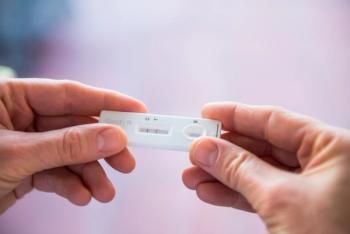
Vitamin D and hypertensive disorders of pregnancy
This article is on based on information presented at the Society for Maternal-Fetal Medicine’s 2021 Virtual Annual Meeting, which was held Jan. 25 to Jan. 30.
For more information, visit
A prospective study has found that even though vitamin D prophylaxis fails to prevent hypertensive disorders of pregnancy, it does increase maternal and cord blood vitamin D levels.
Study results were presented virtually at the 41st Annual Pregnancy meeting of the Society for Maternal Fetal Medicine (SMFM).
At baseline, the incidence of hypertensive disorders of pregnancy was 10.5%. But vitamin D prophylaxis 3,000 IU did not decrease the frequency of hypertensive disorders of pregnancy compared to women who did not receive the prophylaxis: 13.1% vs. 7.7%, respectively (P = 0.10).
However, women who received vitamin D prophylaxis had a significantly higher 25-hydroxyvitamin D3 [25(OH)D] delivery serum level and cord blood level than those who did not receive the prophylaxis: 29.18 ng/mL and 33.73 ng/mL vs. 23.79 ng/mL and 26.06 ng/mL, respectively (both P < 0.001).
“Hypertensive disorders of pregnancy is a leading cause of maternal and neonatal morbidity and mortality in the United States,” said principal investigator Malini Persad, MD, MPH, an associate maternal fetal medicine fellowship director and an assistant professor of maternal fetal medicine at Penn State Health Milton S. Hershey Medical Center in Hershey, Pennsylvania. “Consequently, disease prevention has been a focus of many research endeavors, including ours.”
Previous studies have explored the potential benefits of lifestyle modifications, pharmacological intervention and nutritional supplements to reduce hypertensive disorders of pregnancy.
“Vitamin D supplementation, a relatively benign, safe and cost-effective intervention, captured our attention, based on the Cochrane Review’s 2016 metanalysis results of vitamin D and pregnancy,” Persad told Contemporary OB/GYN. “The review demonstrated trends toward a lower incidence of preeclampsia in the supplemented pregnant patient.”
The current single-center study was conducted at Stony Brook University Hospital in New York, with enrollment between October 2016 and September 2019. Of the 412 women enrolled, 95.1% had completed pregnancies for analysis.
Overall, 37% of the 392 women were vitamin D deficient at the start of their pregnancies.
“We had hypothesized that use of vitamin D supplements in an unscreened cohort would decrease the incidence of hypertensive disorders of pregnancy,” Persad said. “Unfortunately, our study demonstrated that antenatal vitamin D use was not effective in decreasing disease onset. This is surprising, given that prevailing studies have highlighted the role of vitamin D in modulating several mechanisms associated with hypertensive disorders of pregnancy, including but not limited to vessel compliance, the maternal immune response, the renin angiotensin response, and placental implantation and angiogenesis.”
Nonetheless, the current study confirms that pregnant women can safely supplement with vitamin D prophylaxis 3,000 IU in conjunction with prenatal vitamin, without harm.
However, there are several clinical questions to consider, according to Persad, about the role of vitamin D in pregnant women: Should vitamin D levels be assessed? Are the cutoffs for vitamin D insufficiency and deficiency the same in pregnant patients? Who is the ideal pregnant patient for vitamin D intervention? How can the intervention be optimized? What are the associated neonatal outcomes?
“Further data in these areas may better inform future guidance on vitamin D screening and treatment in pregnancy,” Persad said.
The updated 2019 Cochrane Review on vitamin D use and pregnancy further validated that supplementation in the vitamin D deficient patient was associated with a decreased risk for preeclampsia. “Given these findings and the connection of vitamin D deficiency to adverse pregnancy outcomes, consideration should be given to screening the pregnant patient and providing intervention if necessary,” Persad said.
__
__
Persad reports no relevant financial disclosures.
Newsletter
Get the latest clinical updates, case studies, and expert commentary in obstetric and gynecologic care. Sign up now to stay informed.
















